It has been said that all the American pioneer really needed was a gun, an axe, and a steel plow. In fact, the John Deere plow probably meant more to the opening and development of the American Cornbelt than any other single invention.
The first plows were very rough wooden tools. They were made to break up the ground so seeds could be planted. They did not turn a furrow or groove, but simply loosened the soil.
People most often used oxen to pull the plow, a very difficult task. In fact, it took two yoke of oxen and three people to plow one acre a day. One person would steer the plow, one would drive the team, and another cleared the blade.

Soon improvements were made in the plow. In the early 1800's the use of steel rather than wood made plowing easier. A knife or rolling cutter was added to help cut through the soil. In 1837 John Deere tried his new type of plow and had a great deal of success.
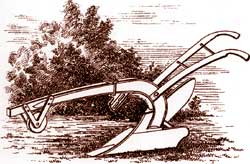
He had taken a saw blade and worked it into the shape of a plow. His new discovery used a self-polishing blade and moldboard (curved iron plate) and pulled easier than any other plow to that time. It soon became the standard all over America.
After 1860 many farmers could plow sitting down.

Later, rotating disks and spring-tooth harrows were added to help break up the ground more easily.
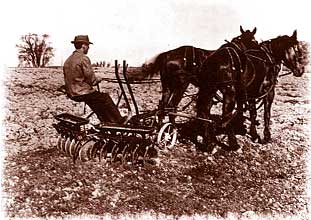
Wheat was the most important small grain crop planted by Iowa farmers. It was not only useful for food but also was easily stored and in great demand as an export product.
Other small grain crops raised included barley, oats, and rye. Barley was useful as livestock, feed, in the preparation of beer and in making bread. Oats supplied the main dish for millions of hardworking horses and supplied oatmeal for hardworking farmers. Rye did well in poor soils and harsh climates.
The earliest farmers planted these crops by hand. They broadcast their seed, that is, they scattered it in the air as they walked across the field. An alternative to broadcast planting was the use of the broadcast seeder. This equipment consisted of a bag with a star-shaped disk at the bottom. As the crank was turned, seed fell onto the rotating disk and scattered across the field.
A later variation of the hand broadcast planter was the horse-drawn broadcast planter. With this device the seed disk was made to spin by the rotation of the wheels as the wagon moved across the field.
With broadcast planting the field had to be harrowed in order to cover as much grain as possible, protecting it from wind, weather and birds.
Throughout the early 1800's inventors worked to improve methods and machinery for planting small grain crops. By the 1860's the grain drill was widely used by farmers in the eastern states. The grain drill didn't come into common use in Iowa until after 1870.
There were many types of drills that were invented and manufactured. Generally, the grain drill was pulled by horses and allowed a space for a rider. A grain box was used to hold a supply of seeds to be planted. The planting mechanism included tubes through which the grain fell into furrows made by discs or shoes attached to the bottom of the drill.
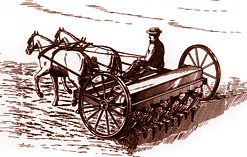
This improved machinery made it possible for farmers to produce more grain per acre and to farm more land.
One of the many things learned from American Indians was the way to make corn. Probably none of the early settlements such as Plymouth and Jamestown could have lived without corn.Corn became a very popular crop because it could be planted and cultivated in rows, was good for humans and livestock, and grew well in the Midwest's climate. Moreover, farmers could produce new varieties of corn by a process called breeding.Corn farming was very different from wheat farming. Corn was planted later in the spring, and therefore harvested after the small grain crops were taken care of. Also, corn crops needed little care in comparison to wheat.During the early years of Iowa's settlement, corn was planted by hand. Hand planters were a very familiar sight on many farms. After 1870 improvements were made over the early tools. Horse-drawn planters, operated by at least two people, were soon commonplace. Straight rows were a matter of pride with the farmer, but very difficult to obtain. After 1870 improvements were made over the early tools. Horse-drawn planters, operated by at least two people, were soon commonplace. Straight rows were a matter of pride with the farmer, but very difficult to obtain.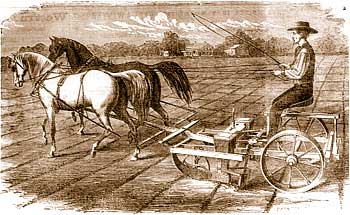 From: Explorations in Iowa History Project, Price Laboratory School, University of Northern Iowa, Cedar Falls, IAPhotos used by permission from the State Historical Society of Iowa. From: Explorations in Iowa History Project, Price Laboratory School, University of Northern Iowa, Cedar Falls, IAPhotos used by permission from the State Historical Society of Iowa. |
After a farmer had planted seeds, the battle against the weeds began. For years hand-power was used to cultivate the land to wipe out seeds. To do this, farmers used hoes usually made of iron by the village blacksmith. Corn farmers usually needed to hoe their crops four times each season. At the rate of ¾ to one acre per day, as much as six days labor per acre might be spent killing weeds.
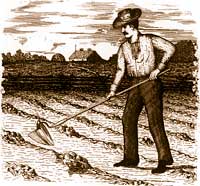
Soon inventors helped farmers cultivate. In about 1820 farmers were using single-row horse-drawn equipment. Its purpose was to loosen the soil and kill weeds. Various types of cultivators quickly followed. Some used the "shovel-plow" which fit easily between corn rows, killed the weeds, stirred the soil, and tilled the plants by throwing more earth around the newly sprouted corn. In fact, the shovel plow remained the common cultivating tool until the 1850's in Iowa and Illinois.
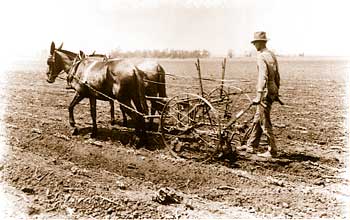
By the late 1860's, horse-drawn two-row cultivators with a seat for the farmer, also called a sulky, were being used in the Midwest.
Harvesting was a very important time for the American farmer. It was the time when the rewards of growing could be clearly seen. Harvest had its own beautiful color and smells.
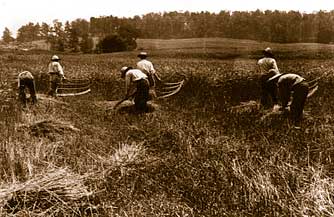
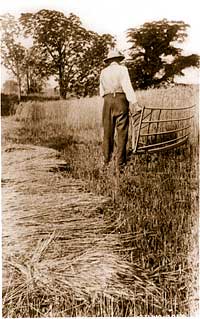 The small grain crops, whether wheat, or some other plant, required much work to harvest. Long ago, before machines helped the farmer, the crop had to be worked by hand. First it had to be cut and then bunched carefully.
The small grain crops, whether wheat, or some other plant, required much work to harvest. Long ago, before machines helped the farmer, the crop had to be worked by hand. First it had to be cut and then bunched carefully.
It would then be tied in a bundle. The bundles were "shocked" or set up in groups of bundles for drying. Once the bundles dried, they were hauled to a specific location to be beaten or tramped on a floor. This grueling and slow work loosened the grains on the stalk. Finally, the chaff had to be separated from the kernels, usually by throwing the whole mixture into the air. This allowed the wind to blow the chaff away.
The introduction of inventions to many of the harvesting stages helped farmers a great deal. Early horse drawn cutters allowed the farmer to sit down while cutting grain.
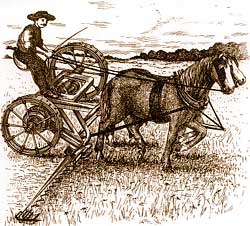
During the 1880's mechanical harvesters were being invented. In addition to cutting the crop by machine, a binding attachment packed and wrapped the bundle with twine.
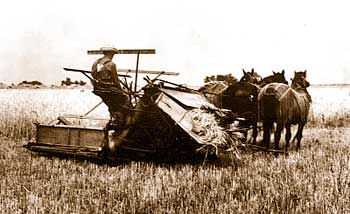
All of the early inventions - reapers, headers, harvesters, and binders - helped farmers to reduce the workload.
The handling of corn is one of the toughest jobs on the farm. For many farmers, it's hard to imagine how corn could be harvested without the sophisticated machinery of today.
A hundred years ago, corn harvesting required more labor than any other farm crop. Corn was used not only for grain, but the stalk and leaves made good feed for horses, cattle, and sheep.
Farmers had to chop down the cornstalks one at a time, and stack them in shocks to dry. A field of shocks, like hundreds of teepees in straight rows, was a magnificent sight.
But this was not all. After the stalks had dried, they were loaded on wagons and taken to the farmstead. Then they were shucked by hand or by machine. Some parts went into the barn for livestock, while the ears were moved to a corncrib for further drying.
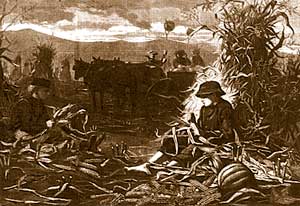
Sometimes the corn was shucked in the field from standing stalks. The ears were stripped from the stalk and tossed into a wagon, which was slowly moved through the field. This greatly increased the farmer's workload and was a terrible task.
As machines were invented, the time needed to harvest corn was lessened. Also, farmers could grow more corn without increasing the workload too much. Early machines took over cutting and bundling of stalks but left a lot of handwork such as hauling and shucking to the farmer.
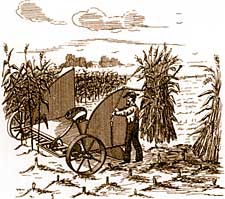
Hay is a mixture of many grasses and other plants. To the farmer, hay is a very important plant. For the most part hay is used for livestock feed. Horses, cattle, hogs and sheep use hay for food. It was, therefore, an important crop on the early farms of Iowa. For many years hay had been cut by a scythe, or sharp knife.
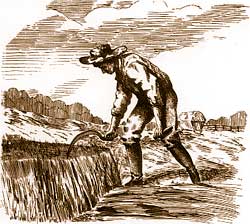
Around the time of the Civil War, workable sickle mowers were invented. The earliest mower was the horse-rake. It was a toothed sickle, which moved rapidly back and forth on a frame and was pulled by a horse. The revolving horse-rake replaced about six people with hand rakes.
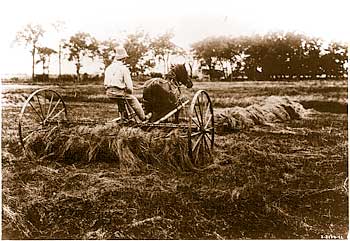
During the late 1860's a seat for a driver was added to the horse rake. This "sulky" had a lever from the rake to the drive, enabling the operator to trip the load when the rake was full.
The other types of rakes, including the side-delivery and sweep types, followed shortly. Each of these rakes attempted to make mowing hay easier for the farmer.
After grain and corn had been harvested, the farmer had to thresh or shell it. Threshing is the process of removing the grain from the heads. Shelling is the removal of the kernels from the ears.
The job of threshing was done by beating the grain out of the heads of the plant. The farmer or thresher would use a short wooden club attached to a long handle with a piece of leather. Obviously, this was hard work and required additional labor to separate the grain from the chaff.
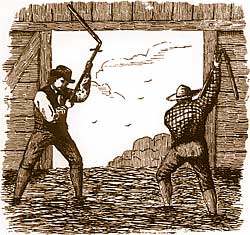
In the late 1700's people invented horse-powered threshing machines to reduce the workload.
In 1837 Hiram A. and John A. Pitts of Maine developed a highly improved thresher. Their machine threshed the grain from the heads, separated the straw by a blower, and removed the chaff from the grain in a single operation.
These newer threshers required a crew of people to operate. Later, steam threshers replaced the horse-powered threshers. They required an engineer and at least fifteen other people. Horse-drawn wagons hauled the grain to and from the thresher. Threshing was a neighborhood operation because of the large number of people it required.
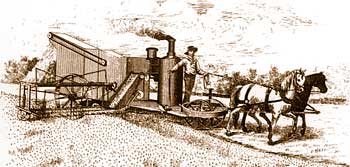
Eventually, in the Great Plains and Far West, a harvester-thresher, or combine, was developed. This greatly reduced the job of harvesting the grain and separating it from the rest of the plant.
In the mid-1800's inventors were also coming up with easier ways of removing the ears of corn from the stalks, stripping the husks, and grinding them into feed called fodder. Most of the husker-shredders worked the same way. Stalks of corn were fed into a roller, which snapped off the ears. The stalks were then pushed through a series of knives and smashed. The shredded fodder then fell into a blower, which passed it through a funnel and out of the machine onto the stack. The ears dropped from the snapping rollers to the husking rollers. Kernels that were removed by the husking rollers fell through a screen, where a fan blew away dirt particles before the grain fell into a box under the machine.
Both the threshing and husking machines were important farm equipment. They made possible increased yields from farmers' fields while reducing the amount of labor.
From: Explorations in Iowa History Project, Price Laboratory School, University of Northern Iowa, Cedar Falls, IA
Photos used by permission from the State Historical Society of Iowa.

Copyright © 2022 CampSilos | All Rights Reserved
National Standards | Silos & Smokestacks | Credits | Awards
Crafted by IFC Studios, a midwest Branding Agency.